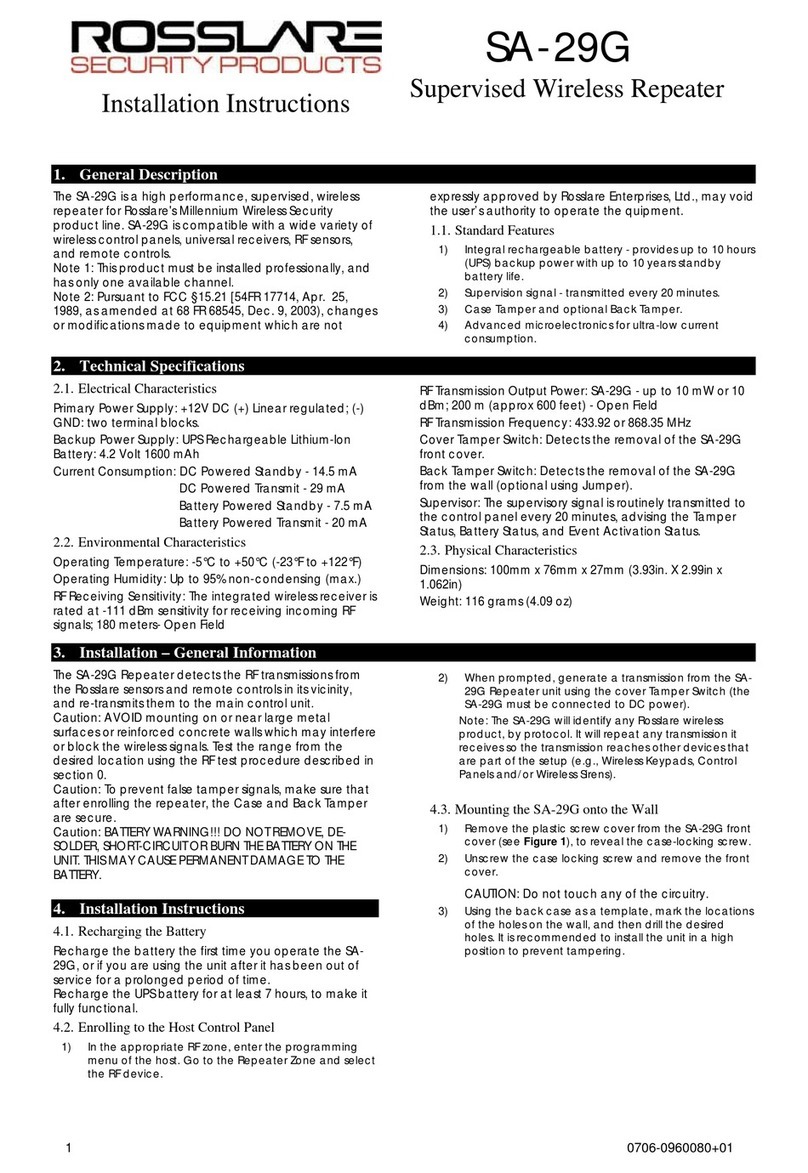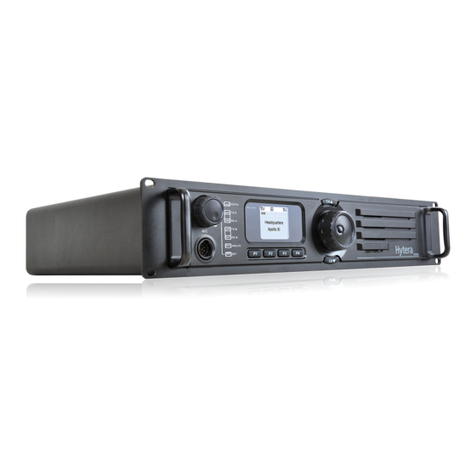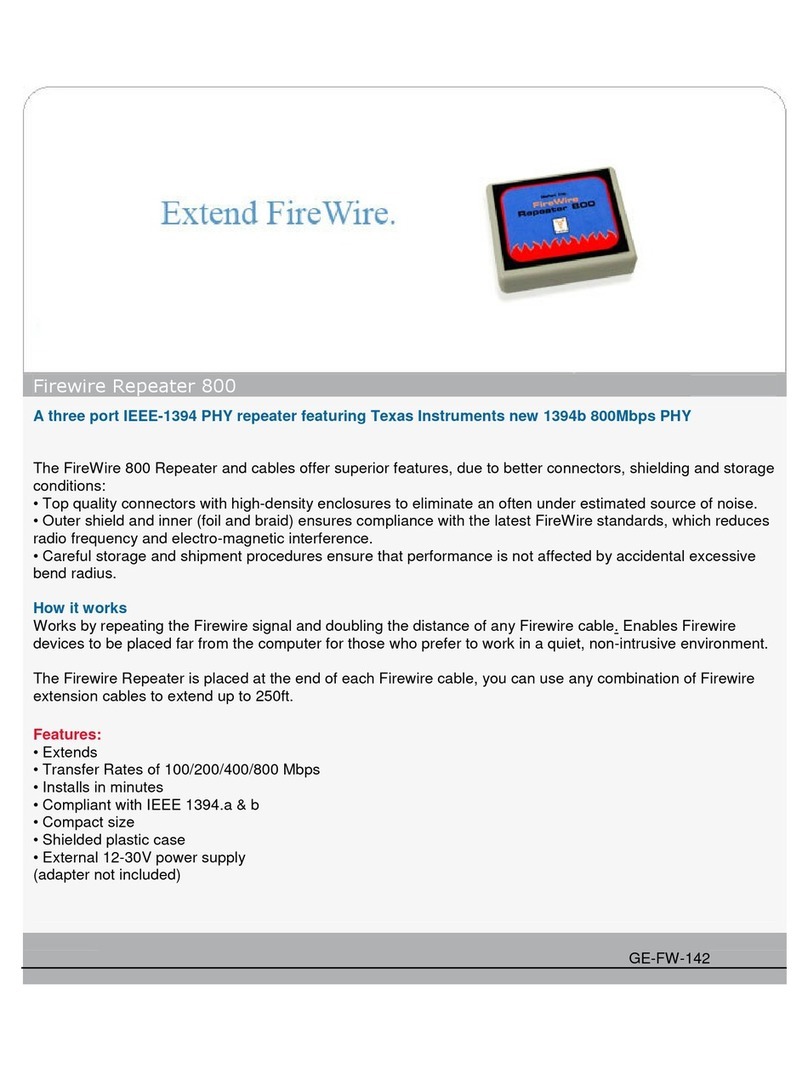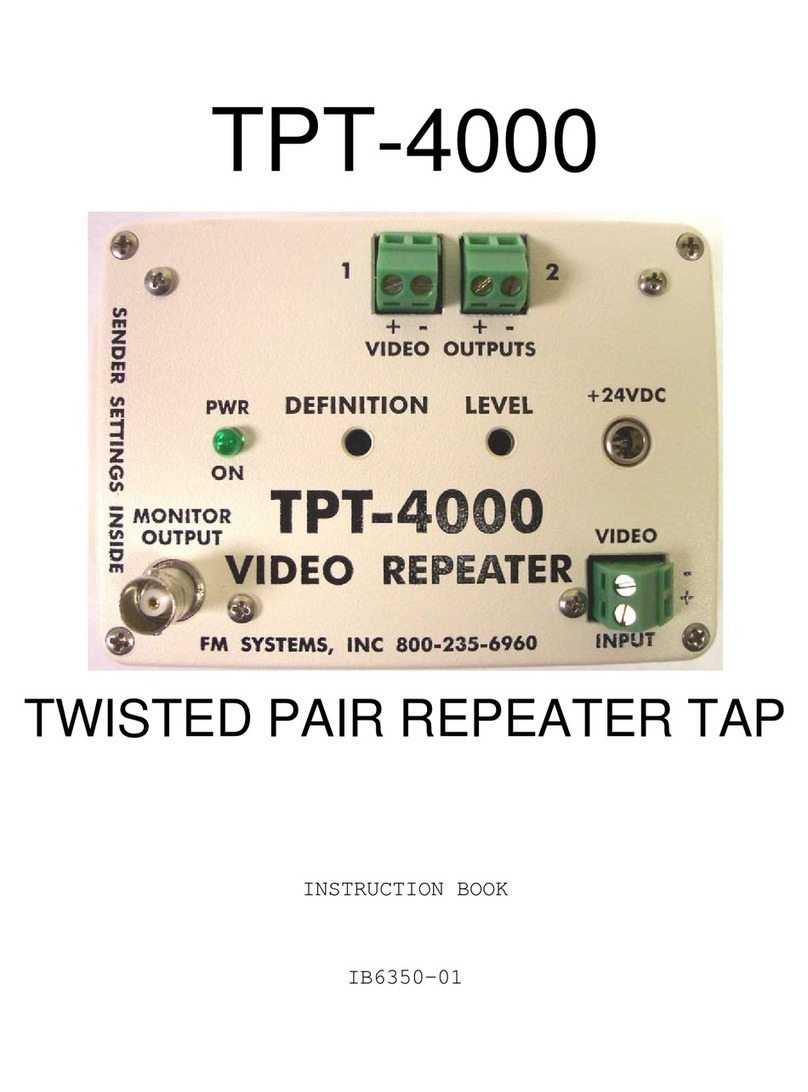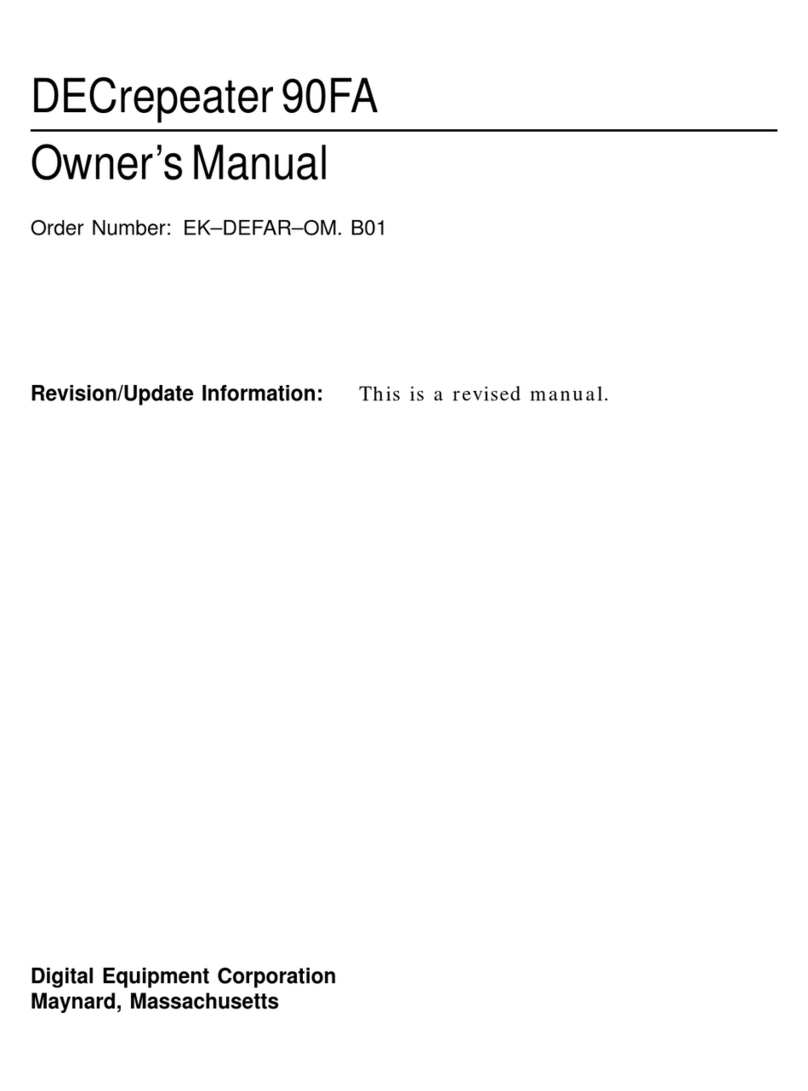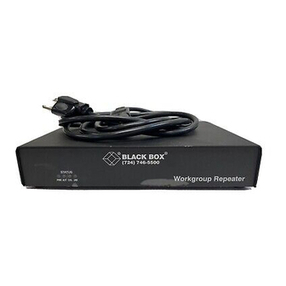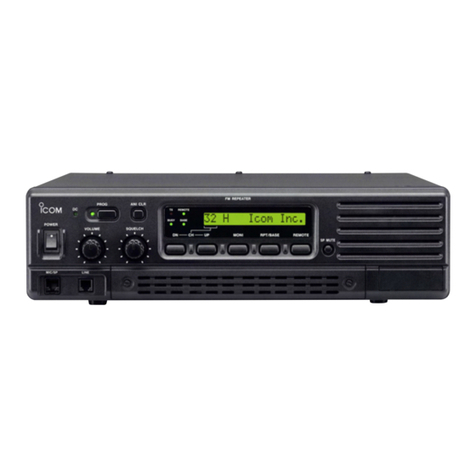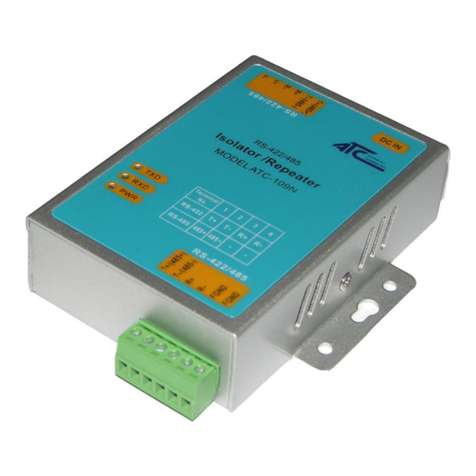ADTRAN HDSL4 T200 H4TU-R Product manual

T200 HDSL4 H4R Repeater
Installation and Maintenance Guide
Document Number: 61223441L2-5A
CLEI: T1RAAAAB_ _
May 2009
®

T200 HDSL4 H4R Repeater Installation and Maintenance Guide
ii 61223441L2-5A
Trademarks
Any brand names and product names included in this document are trademarks, registered
trademarks, or trade names of their respective holders.
To the Holder of this Document
The contents of this document are current as of the date of publication. ADTRAN®reserves the
right to change the contents without prior notice.
In no event will ADTRAN be liable for any special, incidental, or consequential damages or
for commercial losses even if ADTRAN has been advised thereof as a result of issue of this
About this Document
This document provides instructions for the installation and maintenance of the T200 HDSL4
H4R Repeater. The intended audience for this information is the craftperson responsible for
the installation and maintenance of the equipment. These instructions assume familiarity
with the intended use of the equipment, basic required installation skills, and knowledge of
local and accepted safety practices.
Additionally, this document provides provisioning information specific to the User Interface of
the T200 HDSL4 H4R Repeater. The intended audience for this information is system
management personnel responsible for the configuration of the software applications. User
Interface provisioning assumes familiarity with the intended use of the equipment, concepts
peculiar to this product, and a computer operations skill set.
Related information can be obtained by referring to the applicable Job Aid and Compliance
Notice documentation.
901 Explorer Boulevard
P.O. Box 140000
Huntsville, AL 35814-4000
United States
(256) 963-8000
©2009 ADTRAN, Inc.
All Rights Reserved.
®

61223441L2-5A iii
Revision History
Conventions
The following typographical conventions are used in this document:
This font indicates a cross-reference link.
This font indicates screen menus, fields, and parameters.
THIS FONT indicates keyboard keys (ENTER, ESC, ALT). Keys that are to be pressed simultaneously
are shown with a plus sign (ALT+Xindicates that the ALT key and Xkey should be pressed at the
same time).
This font indicates references to other documentation and is also used for emphasis.
This font indicates on-screen messages and prompts.
This font indicates text to be typed exactly as shown.
This font indicates silk-screen labels or other system label items.
This font is used for strong emphasis.
Revision Date Description
A May 2009 Initial release

T200 HDSL4 H4R Repeater Installation and Maintenance Guide
iv 61223441L2-5A
Hazard Classifications
The following hazard classifications are used in this document.
DANGER indicates a hazard with a high level of risk which, if not
avoided, will result in death or serious injury.
WARNING indicates a hazard with a medium level of risk which, if
not avoided, could result in death or serious injury.
CAUTION indicates a hazard with a low level of risk which, if not
avoided, could result in minor or moderate injury. CAUTION can
also be used to alert against unsafe practices associated with
events that could lead to personal injury.
Notice call-outs indicate a potentially hazardous situation not
related to personal injury, such as messages related to property
damage only.
NOTE
Notes inform the user of additional, but essential, information or
features.
Training
ADTRAN offers training courses on our products. These courses include overviews on product
features and functions while covering applications of ADTRAN product lines. ADTRAN
provides a variety of training options, including customized training and courses taught at our
facilities or at customer sites.
For inquiries concerning training, contact ADTRAN:
Training Phone: 800-615-1176, ext. 6303
Training Fax: 256-963-6217
Training Email:[email protected]

61223441L2-5A v
Contents
Introduction . . . . . . . . . . . . . . . . . . . . . . . . . . . . . . . . . . . . . . . . . . . . . . . . . . . . . . . . . . . . . . . . . . . . . . . . . . . . . . 1
Description. . . . . . . . . . . . . . . . . . . . . . . . . . . . . . . . . . . . . . . . . . . . . . . . . . . . . . . . . . . . . . . . . . . . . . . . . . . . . 2
Features . . . . . . . . . . . . . . . . . . . . . . . . . . . . . . . . . . . . . . . . . . . . . . . . . . . . . . . . . . . . . . . . . . . . . . . . . . . . . . 2
Enhanced Features . . . . . . . . . . . . . . . . . . . . . . . . . . . . . . . . . . . . . . . . . . . . . . . . . . . . . . . . . . . . . . . . . . . . . . 2
Electrical Characteristics . . . . . . . . . . . . . . . . . . . . . . . . . . . . . . . . . . . . . . . . . . . . . . . . . . . . . . . . . . . . . . . . . . 3
Compliance . . . . . . . . . . . . . . . . . . . . . . . . . . . . . . . . . . . . . . . . . . . . . . . . . . . . . . . . . . . . . . . . . . . . . . . . . . . . 4
Compatibility . . . . . . . . . . . . . . . . . . . . . . . . . . . . . . . . . . . . . . . . . . . . . . . . . . . . . . . . . . . . . . . . . . . . . . . . . . . 6
Installation . . . . . . . . . . . . . . . . . . . . . . . . . . . . . . . . . . . . . . . . . . . . . . . . . . . . . . . . . . . . . . . . . . . . . . . . . . . . . . . 7
Shipping Contents . . . . . . . . . . . . . . . . . . . . . . . . . . . . . . . . . . . . . . . . . . . . . . . . . . . . . . . . . . . . . . . . . . . . . . . 7
Installing the Module . . . . . . . . . . . . . . . . . . . . . . . . . . . . . . . . . . . . . . . . . . . . . . . . . . . . . . . . . . . . . . . . . . . . . 7
Front Panel LEDs . . . . . . . . . . . . . . . . . . . . . . . . . . . . . . . . . . . . . . . . . . . . . . . . . . . . . . . . . . . . . . . . . . . . . . . 8
Operational Feature Details . . . . . . . . . . . . . . . . . . . . . . . . . . . . . . . . . . . . . . . . . . . . . . . . . . . . . . . . . . . . . . . . . 9
Fault Bridging . . . . . . . . . . . . . . . . . . . . . . . . . . . . . . . . . . . . . . . . . . . . . . . . . . . . . . . . . . . . . . . . . . . . . . . . . . 9
Bad Splice Detection . . . . . . . . . . . . . . . . . . . . . . . . . . . . . . . . . . . . . . . . . . . . . . . . . . . . . . . . . . . . . . . . . . . . . 9
View Splice Results Screen . . . . . . . . . . . . . . . . . . . . . . . . . . . . . . . . . . . . . . . . . . . . . . . . . . . . . . . . . . . 10
Example . . . . . . . . . . . . . . . . . . . . . . . . . . . . . . . . . . . . . . . . . . . . . . . . . . . . . . . . . . . . . . . . . . . . . . . 10
Fast Retrain . . . . . . . . . . . . . . . . . . . . . . . . . . . . . . . . . . . . . . . . . . . . . . . . . . . . . . . . . . . . . . . . . . . . . . . . . . . 11
Isolation Relays . . . . . . . . . . . . . . . . . . . . . . . . . . . . . . . . . . . . . . . . . . . . . . . . . . . . . . . . . . . . . . . . . . . . . . . . 11
Ground Fault or Short Detection . . . . . . . . . . . . . . . . . . . . . . . . . . . . . . . . . . . . . . . . . . . . . . . . . . . . . . . . . . . 12
Connections. . . . . . . . . . . . . . . . . . . . . . . . . . . . . . . . . . . . . . . . . . . . . . . . . . . . . . . . . . . . . . . . . . . . . . . . . . . 13
HDSL4 Deployment Guidelines. . . . . . . . . . . . . . . . . . . . . . . . . . . . . . . . . . . . . . . . . . . . . . . . . . . . . . . . . . . . 14
T200 H4R Capacity Guidelines . . . . . . . . . . . . . . . . . . . . . . . . . . . . . . . . . . . . . . . . . . . . . . . . . . . . . . . . . . . . 15
Maintenance . . . . . . . . . . . . . . . . . . . . . . . . . . . . . . . . . . . . . . . . . . . . . . . . . . . . . . . . . . . . . . . . . . . . . . . . . . . . . 16
Specifications. . . . . . . . . . . . . . . . . . . . . . . . . . . . . . . . . . . . . . . . . . . . . . . . . . . . . . . . . . . . . . . . . . . . . . . . . . . . 17
Appendix A
Warranty and Customer Service . . . . . . . . . . . . . . . . . . . . . . . . . . . . . . . . . . . . . . . . . . . . . . . . . . . . . . . . A-1
ADTRAN Sales . . . . . . . . . . . . . . . . . . . . . . . . . . . . . . . . . . . . . . . . . . . . . . . . . . . . . . . . . . . . . . . . . . . . A-1
ADTRAN Technical Support . . . . . . . . . . . . . . . . . . . . . . . . . . . . . . . . . . . . . . . . . . . . . . . . . . . . . . . . . . A-1
ADTRAN Repair/CAPS . . . . . . . . . . . . . . . . . . . . . . . . . . . . . . . . . . . . . . . . . . . . . . . . . . . . . . . . . . . . . . A-1
Repair and Return Address. . . . . . . . . . . . . . . . . . . . . . . . . . . . . . . . . . . . . . . . . . . . . . . . . . . . . . . . . . . A-1

T200 HDSL4 H4R Repeater Installation and Maintenance Practice
vi 61223441L2-5A
Figures
Figure 1. T200 H4R Front Panel . . . . . . . . . . . . . . . . . . . . . . . . . . . . . . . . . . . . . . . . . . . . . . . . . . . . . . . . . . . 1
Figure 2. View Splice Results Screen . . . . . . . . . . . . . . . . . . . . . . . . . . . . . . . . . . . . . . . . . . . . . . . . . . . . . . 10
Figure 3. HDSL4 Deployment Guideline . . . . . . . . . . . . . . . . . . . . . . . . . . . . . . . . . . . . . . . . . . . . . . . . . . . . 14
Tables
Table 1. T200 H4R Electrical Characteristics . . . . . . . . . . . . . . . . . . . . . . . . . . . . . . . . . . . . . . . . . . . . . . . . . 3
Table 2. T200 H4R Compliance Configuration Codes . . . . . . . . . . . . . . . . . . . . . . . . . . . . . . . . . . . . . . . . . . 4
Table 3. T200 H4R-Compatible ADTRAN HDSL4 Transceiver Units . . . . . . . . . . . . . . . . . . . . . . . . . . . . . . . 6
Table 4. T200 H4R Front Panel LEDs. . . . . . . . . . . . . . . . . . . . . . . . . . . . . . . . . . . . . . . . . . . . . . . . . . . . . . . 8
Table 5. T200 H4R Card Edge Pin Assignments . . . . . . . . . . . . . . . . . . . . . . . . . . . . . . . . . . . . . . . . . . . . . 13
Table 6. T200 H4R Capacity Guidelines for ADTRAN Housings . . . . . . . . . . . . . . . . . . . . . . . . . . . . . . . . . 15
Table 7. T200 H4R Specifications. . . . . . . . . . . . . . . . . . . . . . . . . . . . . . . . . . . . . . . . . . . . . . . . . . . . . . . . . 17

61223441L2-5A 1
T200 HDSL4 H4R Repeater
INTRODUCTION
HDSL4 technology provides extended range T1 (DS1) transport on the telecommunications
network, and features spectral compatibility with ADSL and other transport technologies. The
ADTRAN T200 HDSL4 H4R Repeater (T200 H4R, P/N 1223441L2) regenerates the HDSL4
signal, extending the range of the circuit.
Figure 1 illustrates the T200 H4R front panel.
Figure 1. T200 H4R Front Panel

T200 HDSL4 H4R Repeater Installation and Maintenance Practice
261223441L2-5A
Description
Up to three T200 H4R units work in conjunction with an ADTRAN H4TU-C (Central Office
Transceiver) and an ADTRAN H4TU-R (Remote) to provide DS1 service on the local loop.
• The HRTU-C receives DSX-1 input signals from the network through the chassis,
transports them across the circuit, and terminates them through the H4TU-R. Additionally,
the H4TU-C provides testing, provisioning, and performance monitoring capabilities that
address circuit status.
• The H4TU-R provides a traditional DS1 to customer equipment.
Features
The basic features of the T200 H4R include the following:
• TC PAM line coding
• Lightning protection
• In-band loopback control
• Standard Type 200 or Type 400 form factor repeater, Outside Plant (OSP) apparatus case
design
• Remote provisioning and pass-through performance monitoring
• Fault Bridging (refer to “Fault Bridging” on page 9)
• Bad Splice Detection (refer to “Bad Splice Detection” on page 9)
• Fast Retrain (refer to “Fast Retrain” on page 11)
Enhanced Features
Enhanced features of the T200 H4R include the following:
• Ground Fault Segment Identification
• Loop-to-Loop Detection
• Isolation Relays in the span-powering circuitry, between the network side and customer
side of the repeater (refer to “Isolation Relays” on page 11)
• Ground Fault or Short Detection on the customer side of the repeater (refer to “Ground
Fault or Short Detection” on page 12)

Introduction
61223441L2-5A 3
Electrical Characteristics
That following table lists the electrical characteristics of all four input ports of the T200 H4R
in an unpowered state.
Table 1. T200 H4R Electrical Characteristics
Subscriber Loop Test Set Ohmmeter
T/R T-GND R-GND T/R T-GND R-GND
NET 1 5 365K 365K NET 1 5.8 14.4M 15.6M
NET 2 5 218K 217K NET 2 5.8 16.1M 16.5M
CUST 1 7 91.9K 91.9K CUST 1 5.7 24.4M 24.3M
CUST 2 6 61.2K 61.1K CUST 2 5.9 24.0M 23.8M

T200 HDSL4 H4R Repeater Installation and Maintenance Practice
461223441L2-5A
Compliance
Electrostatic Discharge (ESD) can damage electronic modules.
When handling modules, wear an antistatic discharge wrist strap
to prevent damage to electronic components. Place modules in
antistatic packing material when transporting or storing. When
working on modules, always place them on an approved antistatic
mat that is electrically grounded.
Voltages up to –200 VDC with respect to ground and between
individual telecommunications conductors may be present.
The T200 HDSL4 H4R Repeater is NRTL Listed to the applicable UL standards. The T200 H4R
meets or exceeds all the applicable requirements of NEBS, Telcordia GR-63-CORE, and GR-
1089-CORE. The T200 H4R is intended for deployment in T200 form-factor outside plant
(OSP) apparatus cases and cabinets.
Table 2 lists the compliance codes for the T200 H4R.
This device complies with Part 15 of the FCC rules. Operation is subject to the following two
conditions:
1. This device may not cause harmful interference.
2. This device must accept any interference received, including interference that may cause
undesired operation.
Changes or modifications not expressly approved by ADTRAN could void the user’s authority
to operate this equipment.
Table 2. T200 H4R Compliance Configuration Codes
Configuration Code Input Output
Power Code (PC) C C
Telecommunication Code (TC) X X
Installation Code (IC) A –
C A U T I O N
C A U T I O N
!
SUBJECT TO ELECTROSTATIC DAMAGE
OR DECREASE IN RELIABILITY.
HANDLING PRECAUTIONS REQUIRED.

Introduction
61223441L2-5A 5
The Chassis frame ground terminal must be connected to an earth
ground to ensure that the front panel of the T200 H4R is properly
grounded via the backplane connector.
Per GR-1089-CORE, the T200 H4R is designed and intended for
installation as part of a Common Bonding Network (CBN). The
T200 H4R is not designed nor intended for installation as part of
an Isolated Bonding Network (IBN).
NOTE
The HDSL4 input and output ports are classified as Type 3 and 5,
as defined in Appendix B of GR-1089-CORE Issue 4, and meets the
lightning and power fault criteria with primary protectors that meet
any of the voltage limits of GR-974-CORE or GR-1361-CORE (i.e.,
carbon blocks, gas tubes, and solid state).
NOTE
Current limiting protectors are not required.
NOTE
The T200 H4R is designed to be deployed in GR-3108-CORE
environmental class 2 as defined in GR-3108-CORE issue 2.

T200 HDSL4 H4R Repeater Installation and Maintenance Practice
661223441L2-5A
Compatibility
The T200 H4R is used in conjunction with any T1.418-compliant, span-powering H4TU-C and
H4TU-R. Table 3 list the compatible ADTRAN HDSL4 transceiver units.
Note: x = any generic number; y = any list number
Due to span power limits, the number of T200 H4R units permitted in the circuit depends on
the type of H4TU-C in use. A T200 H4R provides DS1 transport on all revised resistance
design (RRD) 26 AWG loops, 24 AWG loops, or both. Three T200 H4R repeaters can be added
to extend the range of a loop.
The following criteria determines Repeater placement:
• On single T200 H4R loops, consider the attenuation properties of the loop segment.
• For a circuit requiring two T200 H4R units, satisfy both segment attenuation and segment
DC resistance requirements.
• For a circuit requiring three T200 H4R units, satisfy all H4TU-C and H4TU-R hardware
requirements; segment attenuation; and segment DC resistance requirements.
Refer to the “HDSL4 Deployment Guidelines” on page 14 of this guide and the applicable
installation and maintenance guide for the H4TU-C being deployed.
Table 3. T200 H4R-Compatible ADTRAN HDSL4 Transceiver Units
Part Number Unit Name
118141xLyTotal Access 3000 H4TU-C
122x401Ly220 H4TU-C
122x403LyDDM+ H4TU-C
122x404Ly3192 H4TU-C
122x407LySoneplex H4TU-C
122x424LyT200 H4TU-R, Local Power
122x426LyT200 H4TU-R, Span Power

Installation
61223441L2-5A 7
INSTALLATION
After unpacking the T200 H4R, inspect it for damage. If damage has occurred, file a claim with
the carrier then contact ADTRAN Customer Service. Refer to “Appendix A, Warranty” for
further information. If possible, keep the original shipping container for returning the T200
H4R for repair or for verification of shipping damage.
Shipping Contents
The contents include the following items:
• T200 HDSL4 H4R Repeater (P/N 1223441L2)
•T200 HDSL4 H4R Repeater Job Aid (P/N 61223441L2-22)
•T200 HDSL4 H4R Repeater Compliance Notice (P/N 61223441L2-17)
Installing the Module
The T200 H4R is designed for deployment in any Type 200 form-factor enclosure. When
installing the T200 H4R, refer to the appropriate Installation and Maintenance Guide for the
housing being used.
NOTE
Power to the T200 H4R comes from an H4TU-C, independent of
line impedance or wire gauge. The operating power from the H4TU-
C can also span-power the H4TU-R.
To install the T200 H4R, complete the following steps:
1. Hold the T200 H4R by the front panel while supporting the bottom edge of the module.
2. Align the module edges to fit in the lower and upper guide grooves for the enclosure slot.
3. Slide the module into the slot. Simultaneous thumb pressure at the top (above the PWR
LED) and at the bottom (below the electrostatic caution symbol) of the module ensures
that the module is firmly positioned against the backplane of the chassis.
Once the power up self-test is complete, the status LEDs reflect the true state of the hardware
(see Table 4).

T200 HDSL4 H4R Repeater Installation and Maintenance Practice
861223441L2-5A
Front Panel LEDs
The T200 H4R provides front panel LEDs that display status information. Table 4 lists the
T200 H4R LEDs and status descriptions.
Table 4. T200 H4R Front Panel LEDs
Label Status Description
PWR {
z
Off
Green
No span power present
Span power present
NET
LP1/LP2
{
z
4
4
z
4
z
4
Off
Green
Green
(Fast Flashing)
Green
(Slow Flashing)
Yellow
Yellow Flashing
Red
Red Flashing
No span power present
Synchronized with an Signal-to-Noise Ratio (SNR) margin greater
than the SNR Margin Alarm Threshold
Flashing three times per second indicates attempt to synchronize
with the H4TU-C
Flashing once per second indicates synchronization with a SNR
margin greater than the SNR Margin Alarm Threshold; attenua-
tion is greater than the user-recommended Loop Attenuation
Alarm Threshold
Synchronized with a SNR margin greater than 0 dB, but less than
the SNR Margin Alarm Threshold
Synchronized with a SNR margin greater than 0 dB, but less than
the SNR Margin Alarm Threshold; attenuation is greater than the
Loop Attenuation Alarm Threshold
Synchronized with a SNR margin of 0 dB
Flashing once per second indicates synchronization with a SNR
margin of 0 dB; attenuation is greater than the Loop Attenuation
Alarm Threshold
CUST
LP1/LP2
{
z
4
4
z
4
z
4
Off
Green
Green Flashing
(Fast)
Green Flashing
(Slow)
Yellow
Yellow Flashing
Red
Red Flashing
No span power present
Synchronized with an Signal-to-Noise Ratio (SNR) margin greater
than the SNR Margin Alarm Threshold
Flashing three times per second indicates attempt to synchronize
with the H4TU-R
Flashing once per second indicates synchronization with a SNR
margin greater than the SNR Margin Alarm Threshold; attenua-
tion is greater than the Loop Attenuation Alarm Threshold
Synchronized with a SNR margin greater than 0 dB, but less than
the SNR Margin Alarm Threshold
Synchronized with a SNR margin greater than 0 dB, but less than
the SNR Margin Alarm Threshold; attenuation is greater than the
Loop Attenuation Alarm Threshold
Synchronized with a SNR margin of 0 dB
Flashing once per second indicates synchronization with a SNR
margin of 0 dB; attenuation is greater than the Loop Attenuation
Alarm Threshold
LL/RL z
z
4
Green
Yellow
Yellow, Flashing
Loopback active at the H4R towards the H4TU-R
Loopback active at the H4R towards the H4TU-C
H4R armed but not in loopback

Operational Feature Details
61223441L2-5A 9
OPERATIONAL FEATURE DETAILS
The T200 H4R has the following operational features:
• Fault Bridging
• Bad Splice Detection
• Fast Retrain
•IsolationRelays
• Ground Fault or Short Detection
Fault Bridging
The Fault Bridging feature minimizes downtime due to intermittent impairments that appear
on the cable pair, for example, from a Ground Fault Interrupt (GFI), short, micro-interruption,
bad splice, or noise burst. This feature allows the DSL transceivers to maintain synchroni-
zation during an interruption, thus avoiding a 25 to 30-second retrain. Depending on the type
of impairment, interruptions up to 200 ms can be bridged.
Bad Splice Detection
This T200 H4R supports the Runtime TScan 2.0™ bad splice detection feature, an ADTRAN
proprietary, non-intrusive algorithm for detection of anomalies (bad splices) in the copper
plant. This feature monitors the cable pair during runtime for the presence of bad splices that
can potentially impact service.
Poor cable splices are often undetected by normal testing methods. Often, these splices
present no problem for the data transmission equipment until oxidation with the splice itself
causes a rapid impedance change, which can cause errors, signal margin fluctuation, and
retrain of the DSL transceivers. The splice detection feature is available from the Trouble-
shooting Screen through the craft access port.
Data transmission transceivers (especially echo-cancelled technologies) are subject to perfor-
mance degradations and errors in the presence of bad splices. A splice may be benign for a
time, allowing a circuit to behave appropriately for portions of the day. However, over time the
splice oxidizes and incurs small, rapid changes in impedance. This inconsistency in behavior
makes the problem difficult to locate. Additionally, an impedance change that is large enough
to cause the transceiver trouble can still be small enough to be undetectable by test
equipment used on the copper pairs. Therefore, a non-intrusive method of identifying these
bad splices has been developed to aid the customer in troubleshooting the distribution plant.
NOTE
The Splice Detection Feature is a troubleshooting aide. Due to
inconsistency in environmental conditions and their effect on
telecommunications plant, ADTRAN cannot guarantee the
accuracy of the measurements. Comparison to existing engineering
drawings can provide exact locations of suspect splices indicated
by ADTRAN algorithms.

T200 HDSL4 H4R Repeater Installation and Maintenance Practice
10 61223441L2-5A
Splices that are varying in impedance cause the HDSL data pump to see a reduced and/or
fluctuating signal quality (margin). The HDSL data pump attempts to track these changes.
When the changes become too severe, errors or loss of synchronization result.
View Splice Results Screen
Access to the Bad Splice Detection feature is through the Troubleshooting screen, using the
craft access terminal of the H4TU-C or H4TU-R. Selecting the View Splice Results option from
the Troubleshooting screen menu displays the View Splice Results screen (see Figure 2). The
Splice Detection Results column lists the reported results for each transceiver:
• NTF - Indicates that the unit is active and has not detected any problems, or, the number
of detected anomalies have not yet reached the detection count threshold. This threshold
facilitates the reporting of the result to this screen (eight is the present threshold).
• LOS - Indicates that the unit has not detected the remote unit.
• Number - Indicates if the number of times an anomaly was detected exceeds the detection
count threshold of eight. The number in this column represents the number of feet from
the transceiver (Reference Point) to the anomaly. This number also reflects the highest
anomaly count the unit sees, as it is possible to have more than one bad splice per circuit.
This screen reports the worst (most frequently detected) anomaly.
Example
In Figure 2, the View Splice Results screen example shows that a detection has occurred
approximately 650 feet from an H4TU-C module on Loop 2 of the HDSL4 circuit.
Figure 2. View Splice Results Screen
Circuit ID:HTSVALHDSL4 MM/DD/YY hh:mm:ss
Press ESC to return to previous menu
* Note: Chronic Circuit Results are only valid after all other circuit *
* qualification tests have been performed and failed to show a trouble !! *
Splice Detector Version 1 Result Definitions:
---------------------------------------------
NTF - No Trouble Found yet.
LOS - Unit not in sync.
Number - Distance from Reference point (in ft.) of suspect splice.
Reference Splice Detection Results Version Result Shown
Point Loop 1 Loop 2 Number for date
--------- ---------- ---------- ------- MM/DD/YY
H4TUC NTF 650 01 --------
H4TUR NTF NTF 01 06/17/04
H4RU1 NET NTF NTF 01
H4RU1 CST NTF NTF 01 (B)Back

Operational Feature Details
61223441L2-5A 11
Fast Retrain
Fast Retrain is an ADTRAN-proprietary feature that minimizes downtime when an inter-
mittent, non-power related impairment (bad splice, noise burst, etc.) affects the HDSL loop
and cannot be bridged.
When such an impairment occurs after achieving HDSL synchronization, Fast Retrain
restores service within five to seven seconds. This short retrain time allows for reduced
downtime compared to the traditional 25 to 30-second retrain duration.
NOTE
For proper functionality, install Fast Retrain capable units on both
ends of the circuit. Failure of a Fast Retrain attempt initiates the
traditional (25 to 30-second) retrain.
HDSL2 and HDSL4 transceivers normally train in approximately 25 to 30 seconds. For an
initial circuit turnup, this is not a significant issue. However, once service has been estab-
lished on the circuit, any large down-time will interrupt communications on the circuit. A loss
of synchronization on the HDSL loop can cause excessive down times due not only to the 30-
second HDSL retrain time, but also further delays due to the higher level protocols in the
network going through re-synchronization. On the older generation HDSL2 and HDSL4 units,
a one-second loss of HDSL frame synchronization would cause the data pumps to retrain.
This retrain would take approximately 25 seconds, during which AIS would be sent to the
terminating equipment. The reception of AIS by the terminating equipment could trigger
higher level protocol re-synchronizations.
If an impairment (for example, a bad splice) causes the HDSL data pump to lose frame
synchronization for 500 msec or longer, the system attempts a Fast Retrain (instead of
retraining). This abbreviated train can achieve data mode in five to seven seconds. A
successful fast retrain should be evident on the Span Status screen, and also by the reduced
unavailable seconds (UAS) in the PM data for each LOS alarm recorded.
Isolation Relays
Isolation relays are normally open without span powering. Once span powering is detected on
the network side, the T200 H4R monitors the customer-side to determine if a short or ground
fault condition exists. If no short or ground fault is detected, the T200 H4R will close the relay,
allowing span powering to pass from the network to the customer side.

T200 HDSL4 H4R Repeater Installation and Maintenance Practice
12 61223441L2-5A
Ground Fault or Short Detection
If a short or ground fault is detected, the T200 H4R will keep the relays open and continue to
monitor the customer side interface until the fault condition clears. During the fault
condition, the network-side of that repeater can function normally, allowing for synchroni-
zation and loopback/sectionalization testing up to that repeater.
While the short or ground fault condition is present on the customer side of the repeater, the
T200 H4R places a nominal –37 VDC on the customer side, and every three seconds, will
actively monitor the customer-side for the fault to clear. Once the T200 H4R detects that the
condition is clear, the relays close, allowing span powering to pass to the customer side.
The isolation process is only possible if the apparatus case is
properly grounded

Operational Feature Details
61223441L2-5A 13
Connections
All connections are through card edge connectors. Table 5 lists the card edge pin assign-
ments.
NOTE
The T200 H4R dissipates a maximum of 5.4 watts.
Ensure that the chassis ground is securely connected to the
apparatus case. Table 5 lists the ground pin designations.
Table 5. T200 H4R Card Edge Pin Assignments
Pin Description Loop
1 Chassis Ground n/a
5 HDSL4 Loop Tip (Customer) Loop 1
7 HDSL4 Loop Tip (Network) Loop 1
11 Chassis Ground n/a
13 HDSL4 Loop Ring (Network) Loop 1
15 HDSL4 Loop Ring (Customer) Loop 1
17 –48 VDC Return (Ground) n/a
27 Chassis Ground n/a
41 HDSL4 Loop Tip (Network) Loop 2
47 HDSL4 Loop Ring (Network) Loop 2
49 HDSL4 Loop Ring (Customer) Loop 2
55 HDSL4 Loop Tip (Customer) Loop 2

T200 HDSL4 H4R Repeater Installation and Maintenance Practice
14 61223441L2-5A
HDSL4 Deployment Guidelines
Refer to the applicable H4TU-C installation and maintenance guide, HDSL4 Deployment
Guidelines section, for loop parameters, including attenuation and loop resistance consider-
ations.
NOTE
The H4TU-C with part numbers 1221401L6, 1221403L6, and
1221404L6 support only one T200 H4R in the HDSL4 circuit.
Refer to the Detailed Status Screen by accessing the menus on the H4TU-C craft terminal
interface for current Signal-to-Noise Ratio Margin and Attenuation status indications for the
circuit.
Figure 3 illustrates a basic HDSL4 deployment.
Figure 3. HDSL4 Deployment Guideline
1st Segment 2nd Segment 3rd Segment
Other manuals for HDSL4 T200 H4TU-R
3
Table of contents
Other ADTRAN Repeater manuals
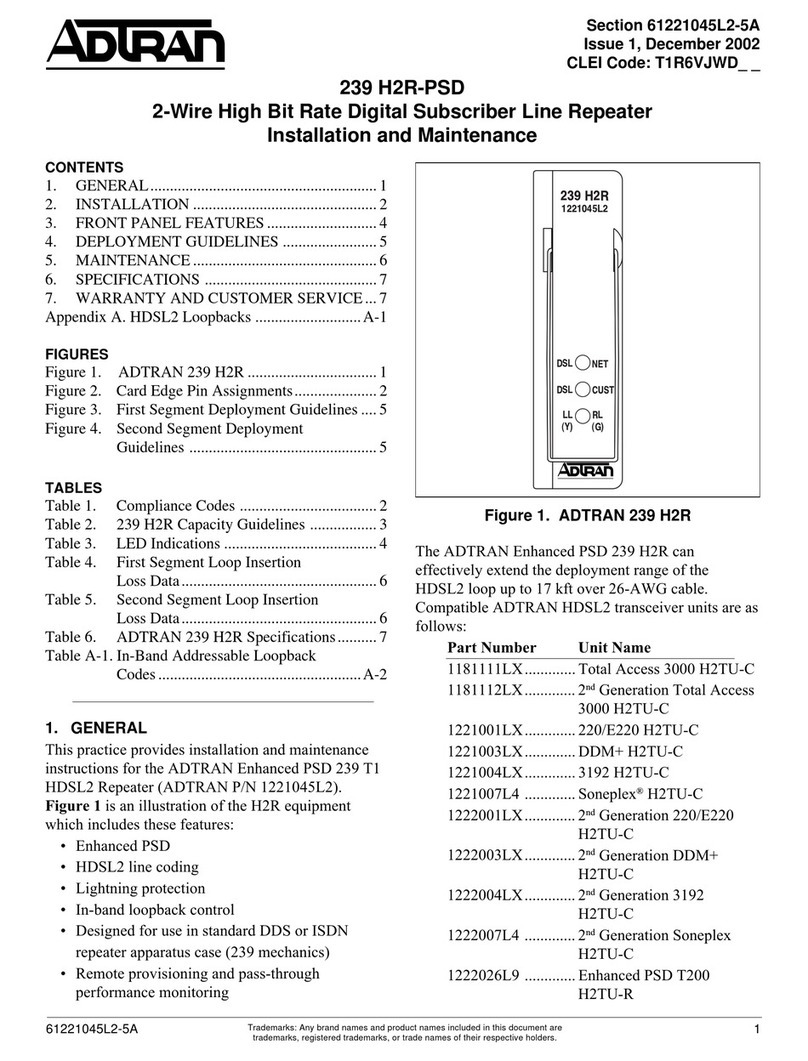
ADTRAN
ADTRAN 239 H2R-PSD Instruction Manual
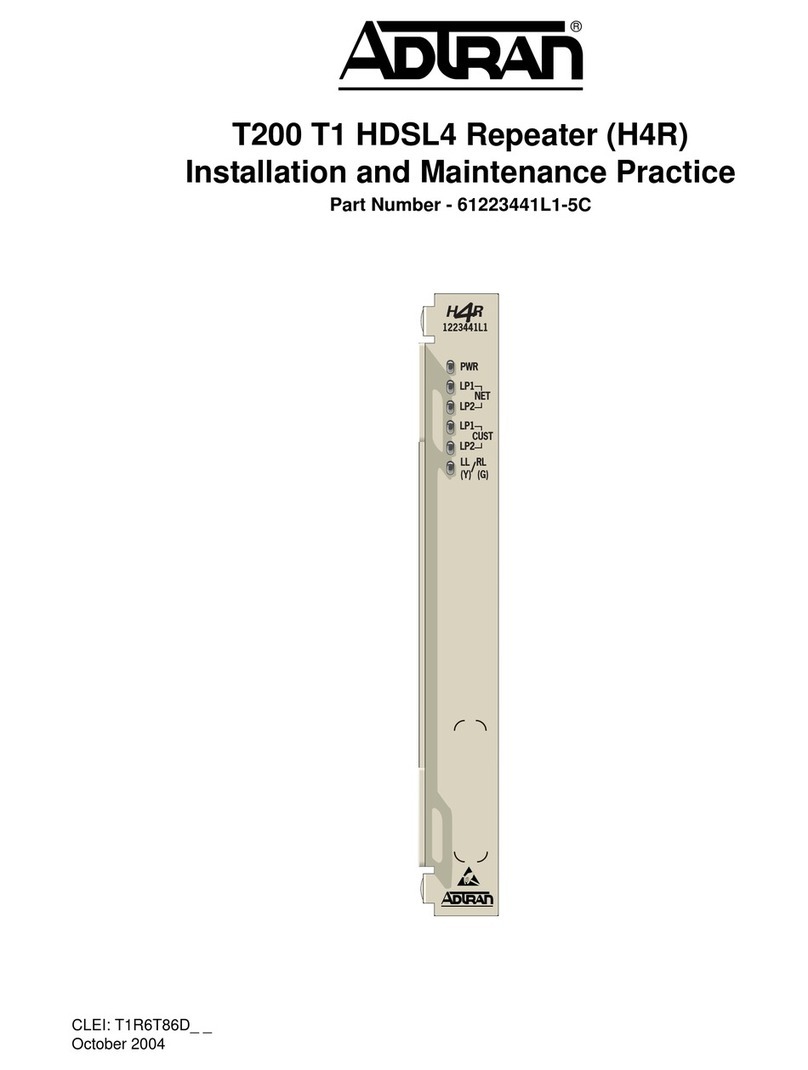
ADTRAN
ADTRAN T200 T1 HDSL4 Instruction Manual
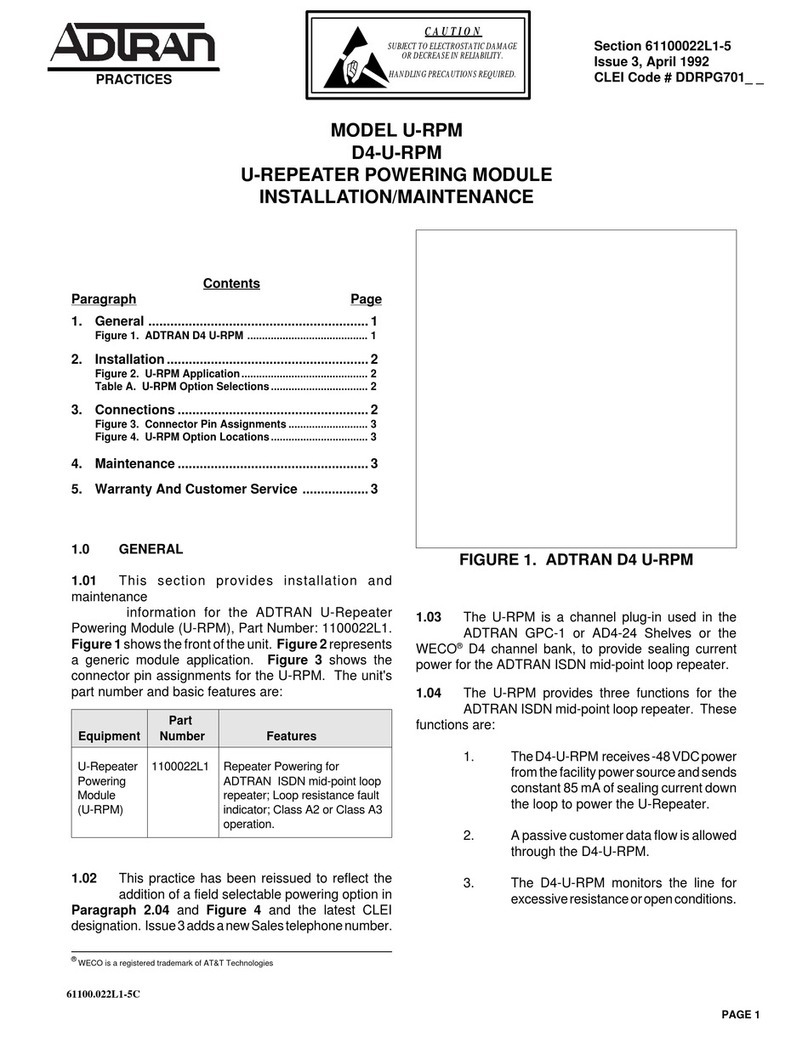
ADTRAN
ADTRAN D4-U-RPM Maintenance and service guide
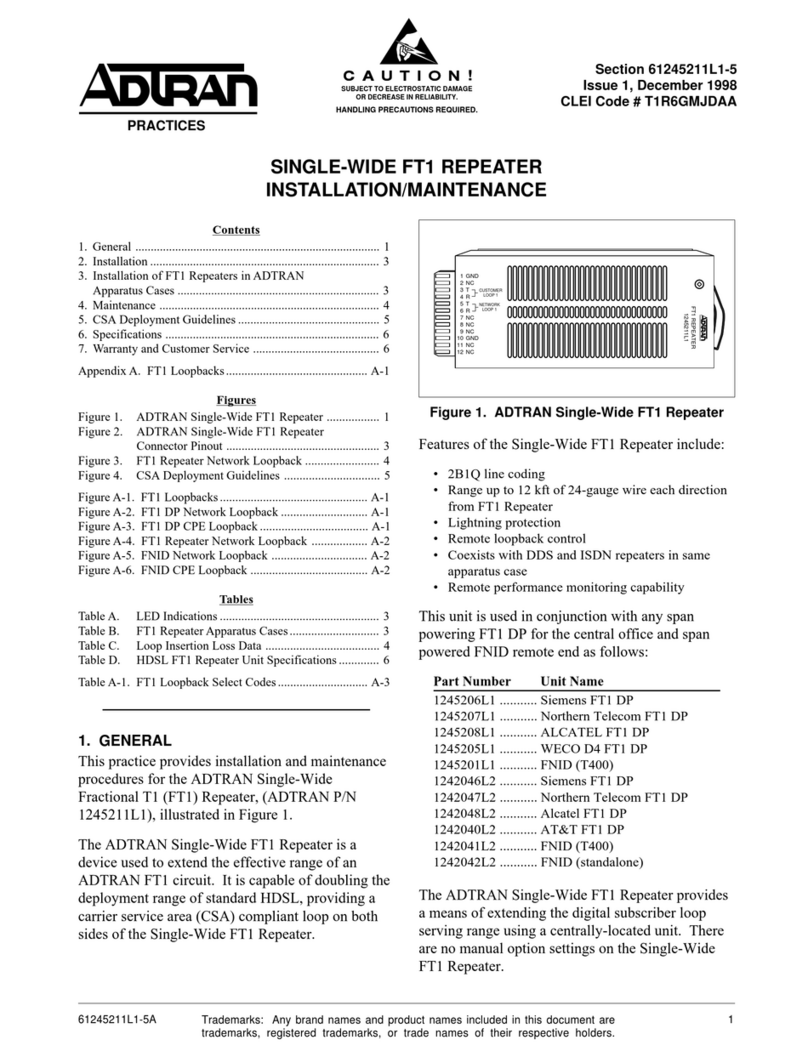
ADTRAN
ADTRAN NetVanta FT1 Maintenance and service guide
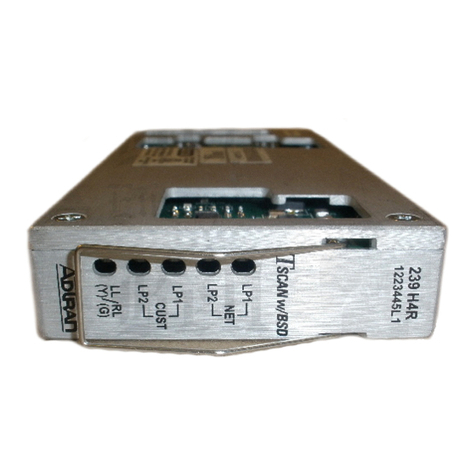
ADTRAN
ADTRAN 239 H4R Instruction Manual

ADTRAN
ADTRAN 239 H4R Instruction Manual
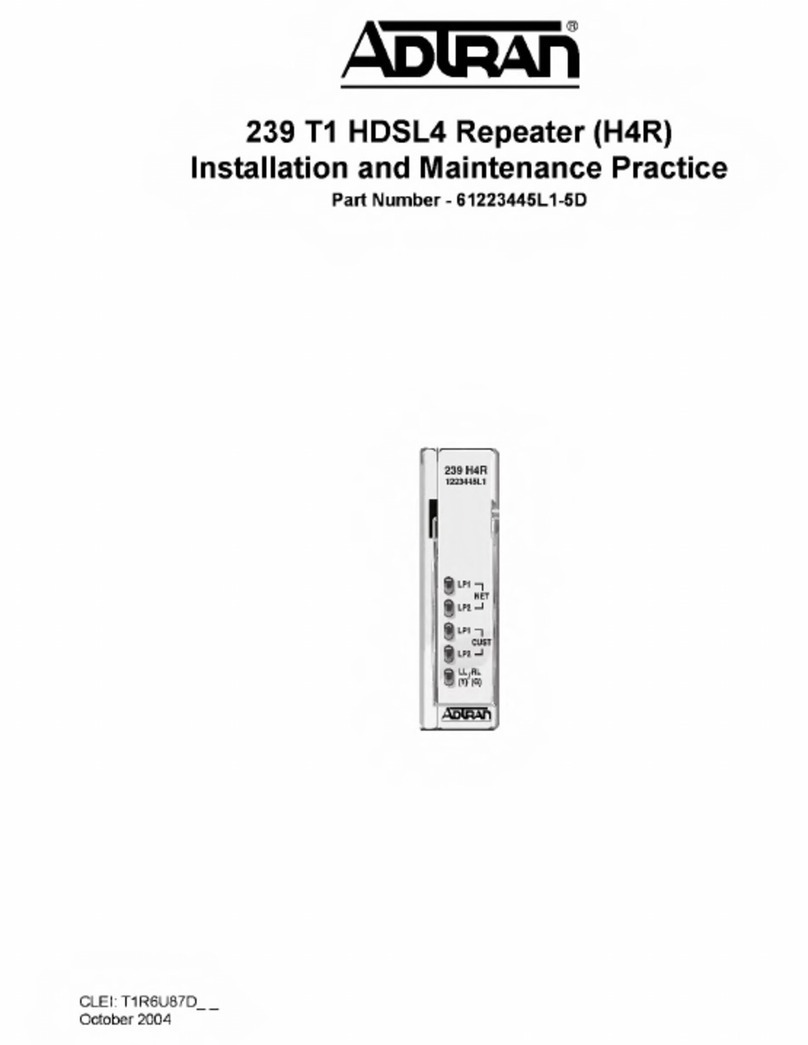
ADTRAN
ADTRAN 239 T1 Instruction Manual
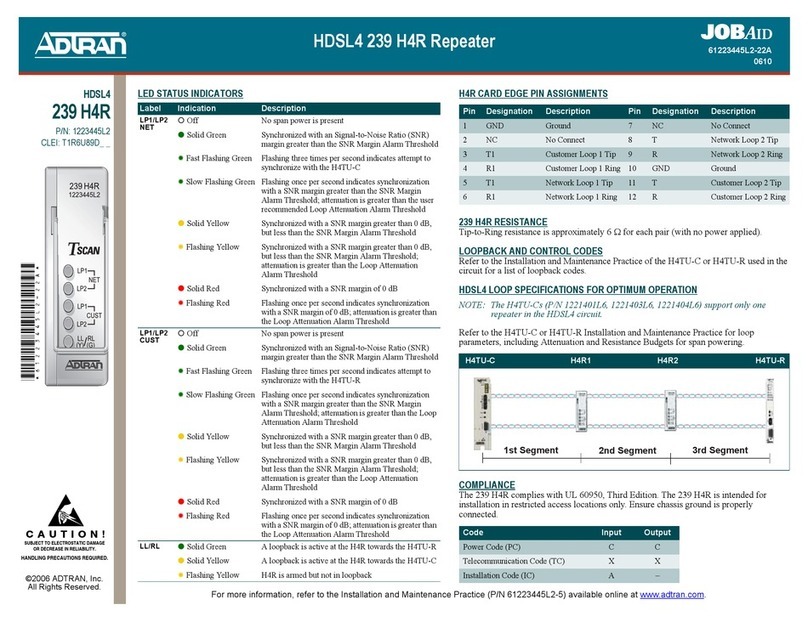
ADTRAN
ADTRAN 1223445L2 User manual
Popular Repeater manuals by other brands
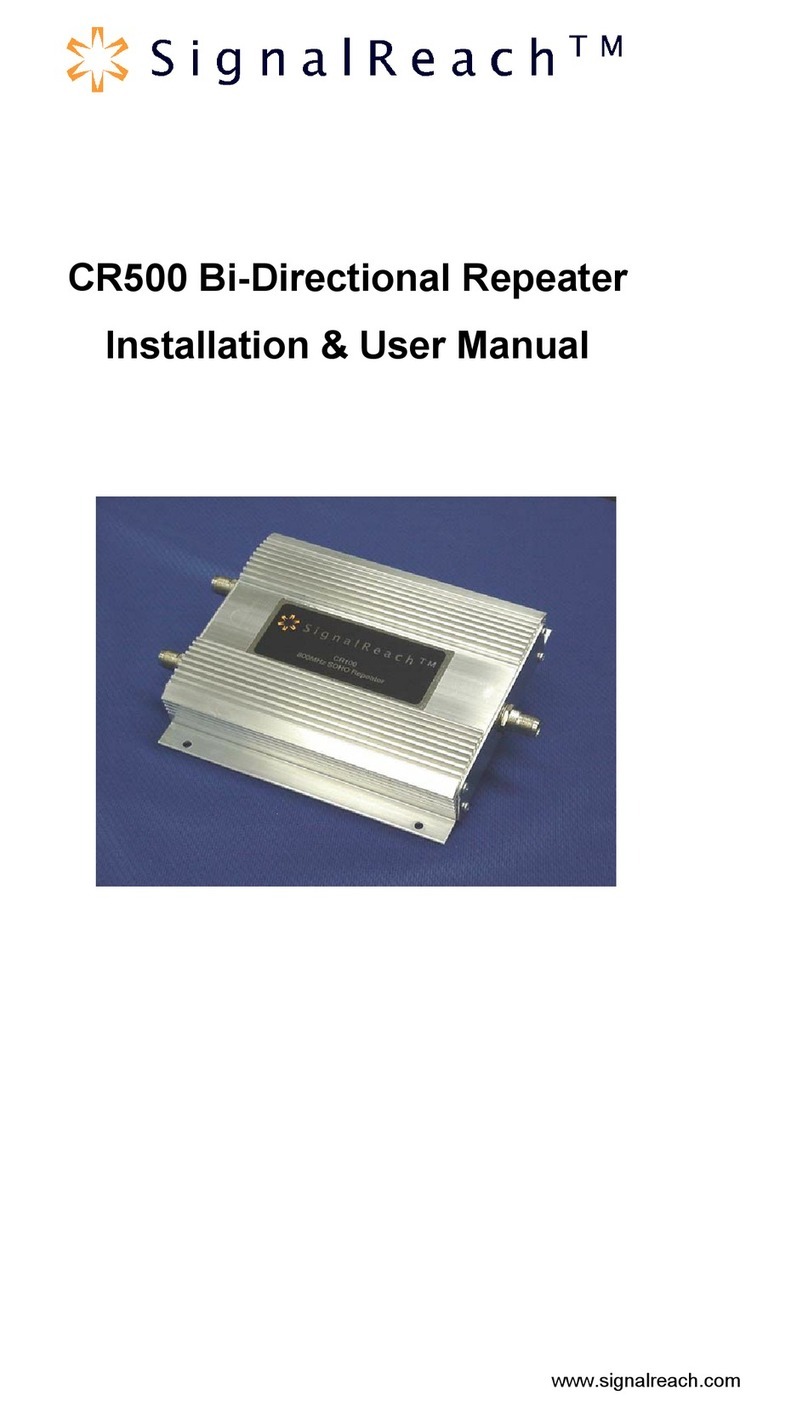
Arrista Technologies
Arrista Technologies SignalReach CR500 Installation & user manual

MORLEY-IAS
MORLEY-IAS ZXr-A Operation & installation manual
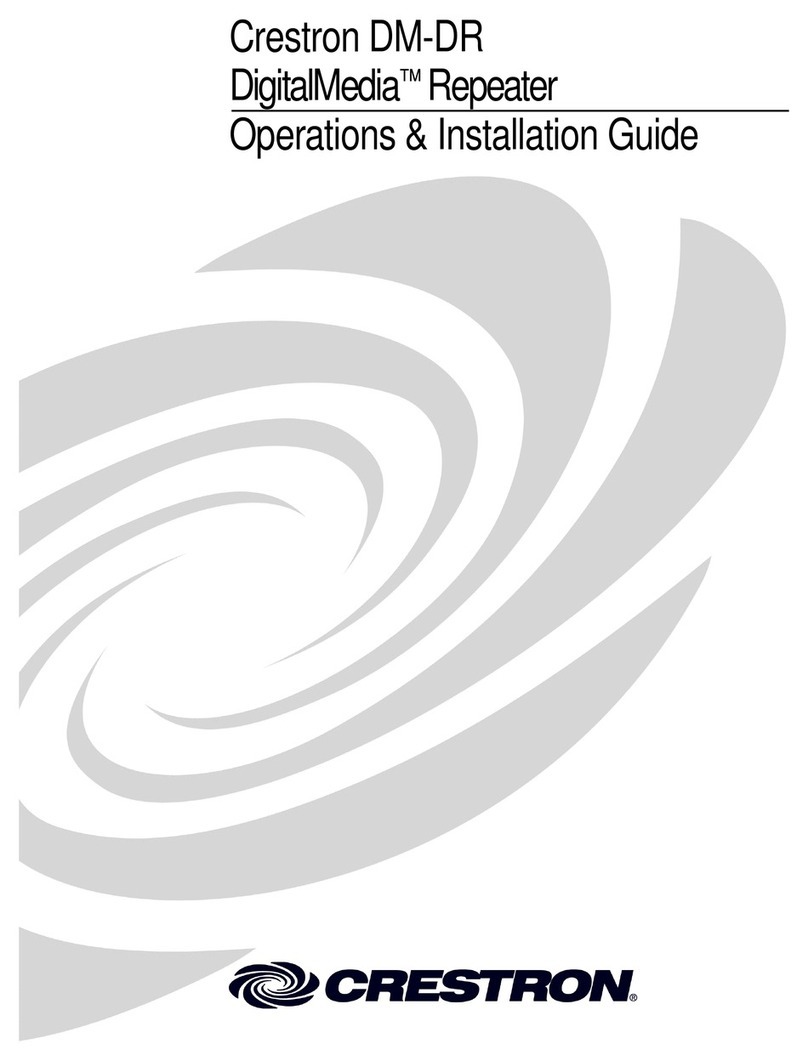
Crestron
Crestron DigitalMedia Repeater DM-DR Operations & installation guide
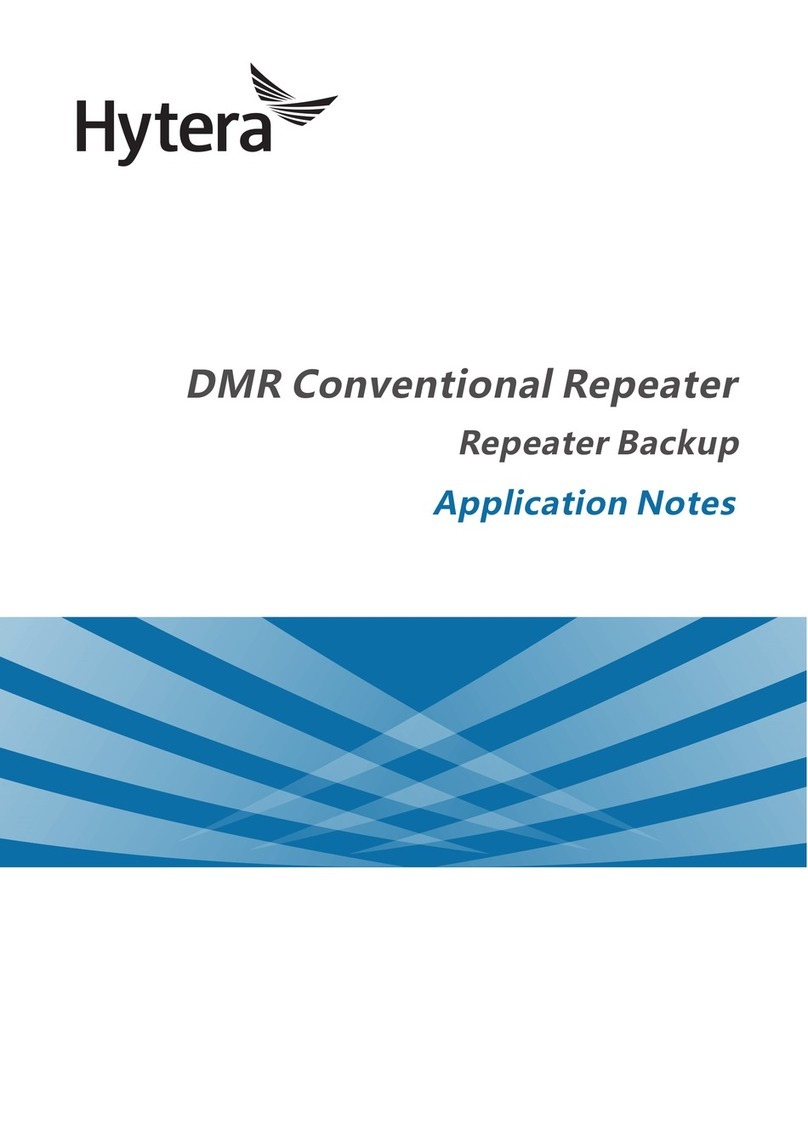
Hytera
Hytera DMR Application note
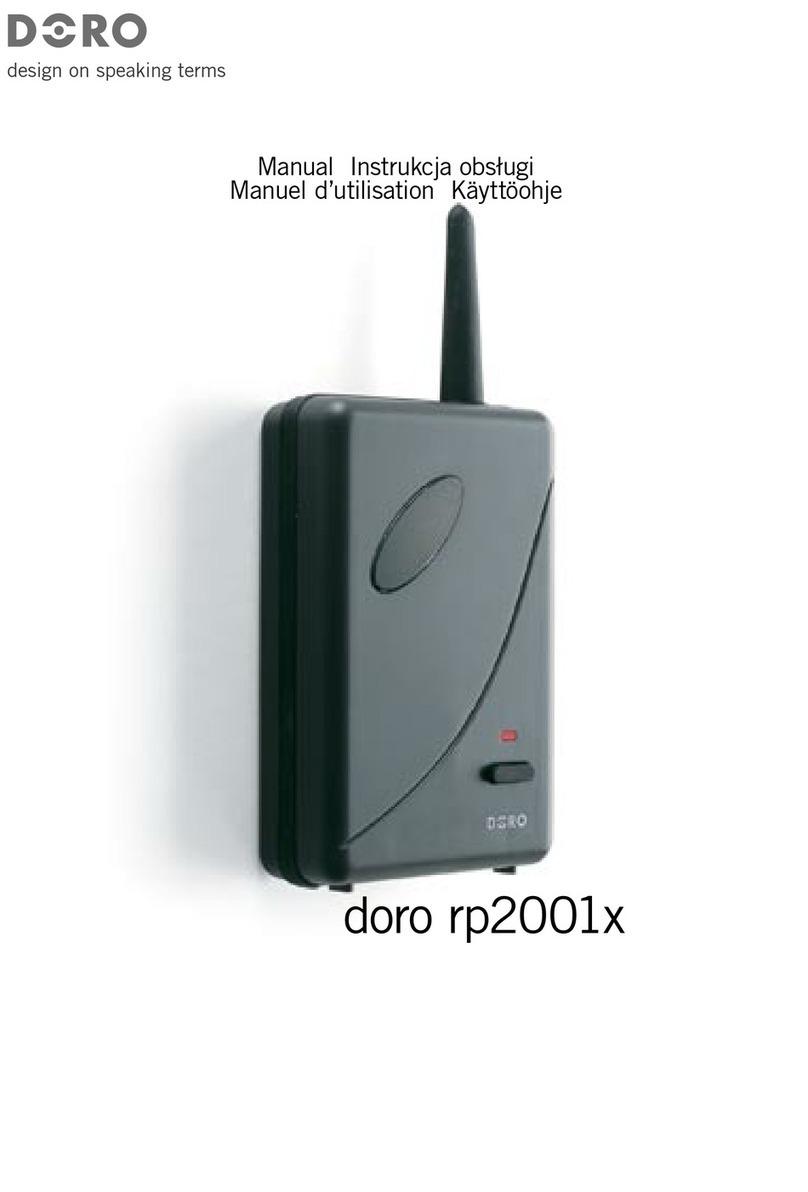
Doro
Doro rp2001x user manual
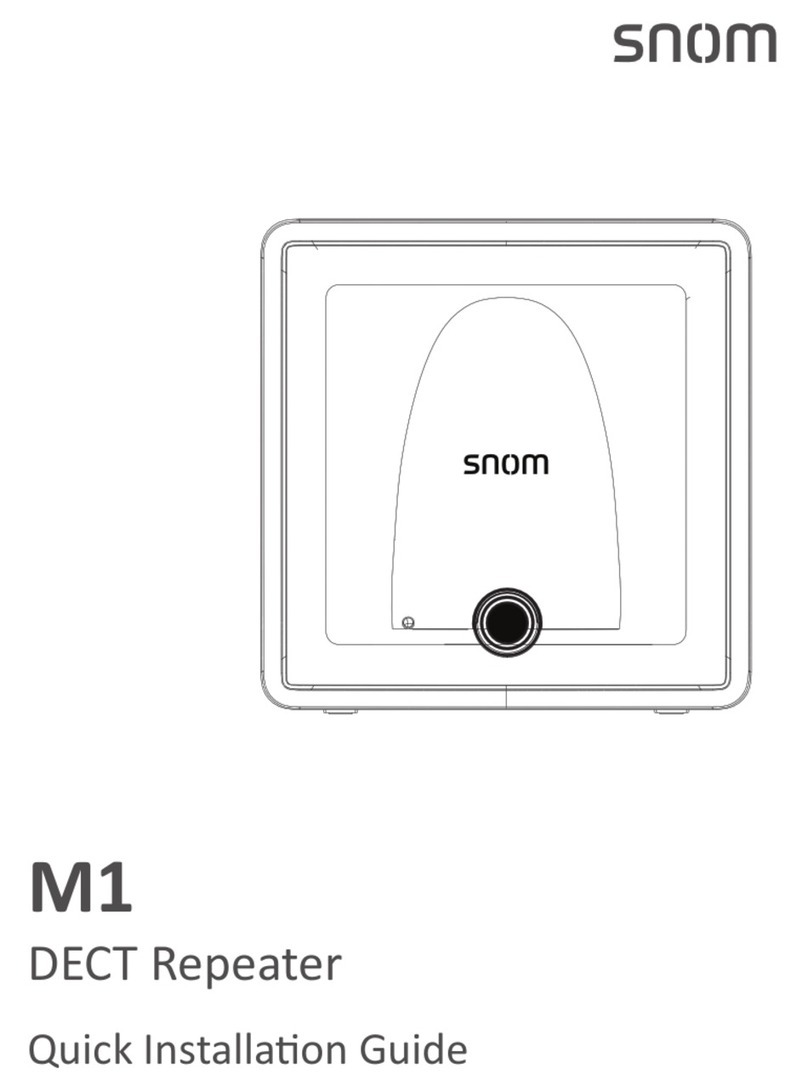
Snom
Snom M1 Quick installation guide
